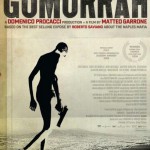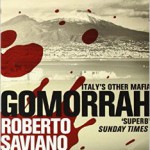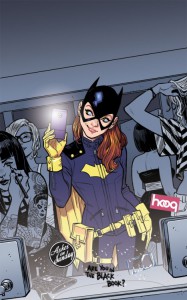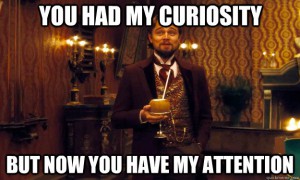Pal Pablo had been telling me about a TV series called Gomorrah. I had seen the movie listed on Netflix and after adding it to my list, obviously, I never went back to it again. “Breaking Bad crossed with The Sopranos, but even better” was his pitch. I wanted to ask him how it rated against The Wire, but I was too afraid to hear the answer so the question remained unasked.
It did not come as a surprise to see that Gomorrah was based on a book; what was surprising was that Roberto Saviano had not written a novel, as I had thought earlier, but an eyewitness account of sorts. It is a book about crime; more specifically, it is about how the dealings of the Italian crime syndicate, the Camorra have seeped into nearly every pore of Neapolitan society. Saviano’s writing describes the criminal empire in words that awaken goose-flesh, beginning with an explosive visual description.
They looked like mannequins, but when they hit the ground, their heads split open, as if their skulls were real. And they were. Men, women and even a few children, came tumbling out of the container. All dead. Frozen, stacked one on top of another, packed like sardines.
The book slithers through history and geography in a very unassuming manner. Saviano talks about the many fingers of the Camorra and the various pies they are dipped into – fashion, drugs, weapons, cement, even garbage disposal. There is a broad cast of characters, almost overwhelmingly so, with names of different Camorristas across time periods, their nicknames, and the acts that brought them notoriety. Sometimes accompanied by the whys of it all.
Carmine Schiavone recounts that they had Salzillo sit at the head of the table, in honor of his uncle. All of a sudden, Sandokan started to strangle him while his cousin and his cohorts held him by the legs and arms. Sandokan could have killed him with a gun or a knife to the stomach, the way the old bosses used to. But no. He had to do it with his hands: that’s the way the new sovereign kills the old one when he usurps the throne. Ever since 1345 when Andrew of Hungary was strangled in Aversa, the result of a conspiracy orchestrated by his wife, Queen Joan I, and the Neapolitan nobles loyal to Charles, Duke of Durazzo, who aspired to the throne, strangulation around here has been a symbol of succession, of the violent turnover of sovereignty. Sandokan had to show all the bosses that he was the heir, that, by right of viciousness, he was the new leader.
My favorite part of the book deals with a Camorrista’s obsession with Mikhail Kalashnikov – he finally did get to see the man and gave him a box of mozzarella from Naples. By that time, Kalashnikov a retired general who sort of lived off the glory of creating the most efficient killing machine of all time. How efficient?
Nothing in the world—organic or synthetic, metal or chemical—has produced more deaths than the AK-47. It has killed more than the atom bombs dropped on Hiroshima and Nagasaki, more than HIV, more than the bubonic plague, more than malaria, more than all the attacks by Islamic fundamentalists, more than the total of all the earthquakes that have shaken the globe. An exponential amount of human flesh, impossible to even imagine. Only one image came anywhere close to a convincing description, an advertisement at a convention: fill a bottle with sugar by pouring the grains from a small hole in the corner of the bag. Each grain of sugar is someone killed by a Kalashnikov….To calculate the state of human rights, the analysts consider the price of an AK-47. The less it costs, the more human rights violations there are, an indication that civil rights are gangrening and the social structure is falling to pieces. In western Africa, an AK-47 can cost as little as $50. And in Yemen it is possible to find second-or thirdhand weapons for as low as six dollars.
Of course, there is an ample amount of black humor throughout the book, despite the matter-of-fact telling. It does make me wonder how much nuance is lost in translation.
Mariano spent the entire morning at Kalashnikov’s house. The Russian who introduced him must have been quite influential for the general to treat him so warmly. The video camera was running as they sat at the table and a tiny, elderly lady opened the Styrofoam box of mozzarella. They ate with relish. Vodka and mozzarella. Mariano wanted to record it all, so he set the camera at the head of the table. He wanted proof that General Kalashnikov ate the mozzarella from his boss’s dairy. In the background the lens also captured a piece of furniture covered with framed photos of children.
“Mariano, Kalashnikov has that many children and grandchildren?”
“They’re not his children! They’re all photos people send him of children named after him, people whose lives were saved by a Kalashnikov or who simply admire him.”
Like doctors who put pictures of children they have treated on their office shelves as mementos of their professional success, General Kalashnikov had photographs of children named after his creature in his living room. A well-known guerrilla fighter with the Popular Liberation Movement in Angola once told an Italian reporter, “I named my son Kalash because it is synonymous with liberty.”
Speaking of mozzarella, this segment in the section on the Camorra’s methods of waste disposal in Italy made me want to avoid milk for the rest of my life.
Near Villaricca the carabinieri identified a piece of land where paper towels from hundreds of dairy farms in the Veneto, Emilia-Romagna, and Lombardy had been dumped: towels used for cleaning cow udders. Farmhands have to clean the udders constantly—two, three, four times a day—every time they attach the suction cups of the automatic milker. As a result the cows often develop mastitis and similar diseases and begin to secrete pus and blood. They’re not allowed to rest, however. Their udders are simply cleaned every half hour so that the pus and blood do not get into the milk and ruin an entire can. Maybe it was just my imagination, or perhaps the heaps of yellowish udder paper distorted my senses, but they smelled like sour milk. The fact is that the trash, accumulated over decades, has reconfigured the horizons, created previously nonexistent hills, invented new odors, and suddenly restored lost mass to mountains devoured by quarries.
Through the facts and the hearsay, there is Saviano’s cynical observations on the human condition in his homeland.
In Naples cruelty is the most complex and affordable strategy for becoming a successful businessman. The air of the city smells like war, you can breathe it through every pore; it has the rancid odor of sweat, and the streets have become open-air gyms for training to ransack, plunder, and steal, for exercising the gymnastics of power, and the spinning of economic growth.
The economic power of the Camorra System lies exactly in its continual turnover of leaders and criminal choices. One man’s dictatorship is always brief; if the power of a boss were long-lasting, he would raise prices, create a monopoly, making rigid markets, and keep investing in the same sectors rather than exploring new ones. Instead of adding value in the criminal economy, he would become an obstacle to business. And so, as soon as a boss takes over, others ready to take his place start to emerge, figures eager to expand, to stand on the shoulders of the giants they helped create. Something that the journalist Riccardo Orioles, one of the most astute observers of power dynamics, always remembered: “Criminality is not power pure and simple, but one kind of power.” There will never be a boss who wants a seat in government. If the Camorra had all the power, its business, which is essential to the workings of the legal and illegal scale, would not exist. In this sense every arrest and maxi-trial seems more like a way of replacing capos and breaking business cycles than something capable of destroying a system.
There are nuggets of history revealed throughout the book, like this mention of the other book about Italian crime families that also starts with a “G”.
Mario Puzo’s inspiration was not a Sicilian but Alfonso Tieri, boss of Pignasecca in downtown Naples, who became the head of the leading Italian Mafia families in the United States after the death of Charles Gambino. In an interview for an American newspaper, Antonio Spavone ‘o malommo, or “bad man,” the Neapolitan boss linked to Tieri, stated, “If the Sicilians showed how to keep their mouths shut, the Neapolitans showed the world how to behave when you’re in command. To convey with a gesture that commanding is better than fucking.” Most of the criminal archetypes, the acme of Mafia charisma, were from a few square miles of Campania. Even Al Capone was originally from here; his family came from Castellammare di Stabia. Capone was the first boss to measure himself against the movies. His nickname, Scarface, from a scar on his cheek, was used by Brian De Palma for his 1983 film about Tony Montana, but Howard Hawks had used it previously for his 1932 movie about Capone. Capone and his escort would show up on the set every time there was an action scene or location shot he could watch. The boss wanted to make sure that Tony Camonte, the Scarface character he inspired, did not become trite. But he also wanted to make sure he was as much like Tony Camonte as possible; he knew that after the film’s release, Camonte would become the emblem of Capone, rather than the other way around.
Overall, a fantastic read. I will check out the movie and TV series soon, just to see how they storify the book’s non-linear, informational narrative.




 One of the words that might just make into popular lexicon this year would be “Batgirling”. Though the usage and origin is confined to a narrow subset of people: comic book fans. More specifically, comic book fans that read ongoing mainstream titles. I am not one of them. That may soon be changing, thanks to the aforementioned word.
One of the words that might just make into popular lexicon this year would be “Batgirling”. Though the usage and origin is confined to a narrow subset of people: comic book fans. More specifically, comic book fans that read ongoing mainstream titles. I am not one of them. That may soon be changing, thanks to the aforementioned word.